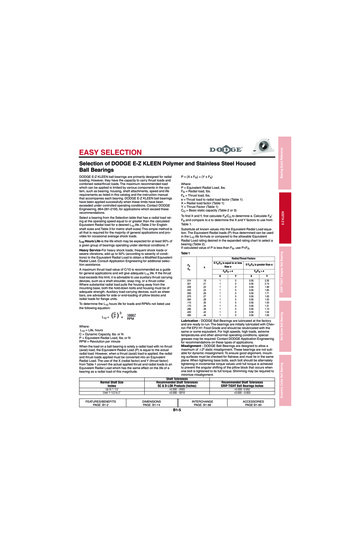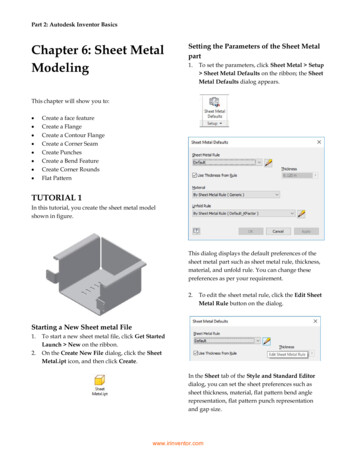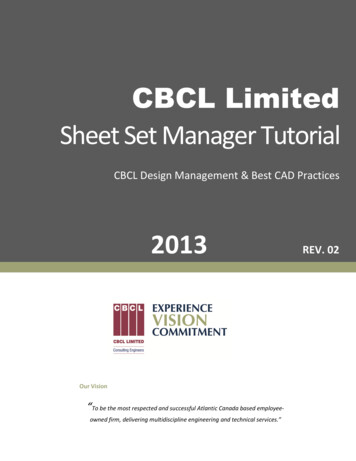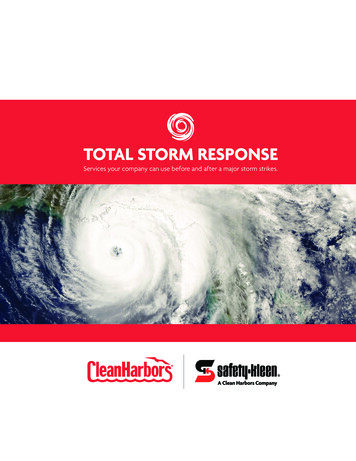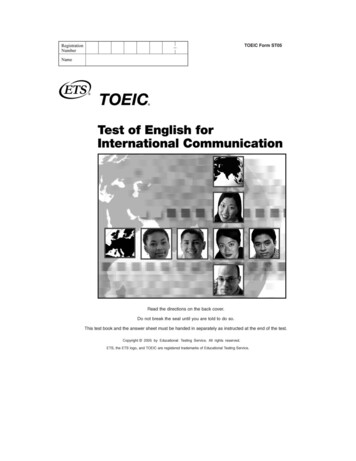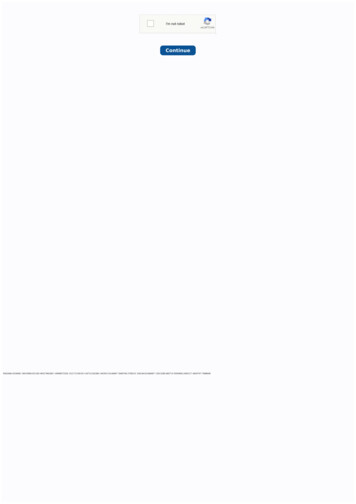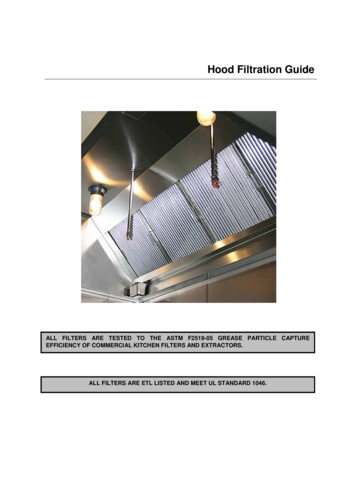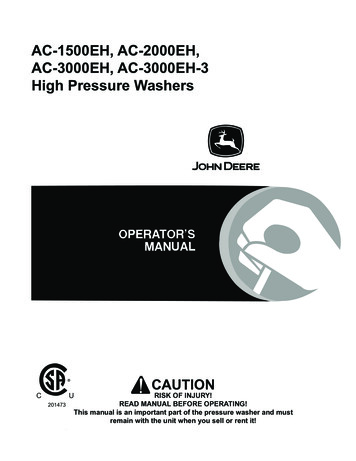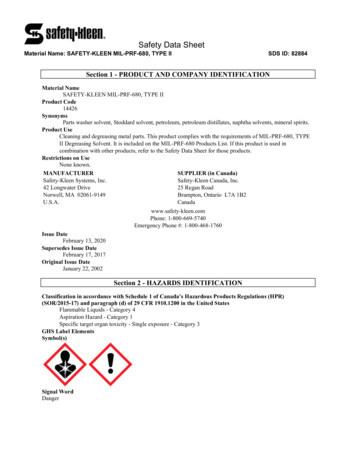
Transcription
Safety Data SheetMaterial Name: SAFETY-KLEEN MIL-PRF-680, TYPE IISDS ID: 82884Section 1 - PRODUCT AND COMPANY IDENTIFICATIONMaterial NameSAFETY-KLEEN MIL-PRF-680, TYPE IIProduct Code14426SynonymsParts washer solvent, Stoddard solvent, petroleum, petroleum distillates, naphtha solvents, mineral spirits.Product UseCleaning and degreasing metal parts. This product complies with the requirements of MIL-PRF-680, TYPEII Degreasing Solvent. It is included on the MIL-PRF-680 Products List. If this product is used incombination with other products, refer to the Safety Data Sheet for those products.Restrictions on UseNone known.SUPPLIER (in Canada)MANUFACTURERSafety-Kleen Canada, Inc.Safety-Kleen Systems, Inc.25 Regan Road42 Longwater DriveBrampton, Ontario L7A 1B2Norwell, MA 02061-9149CanadaU.S.A.www.safety-kleen.comPhone: 1-800-669-5740Emergency Phone #: 1-800-468-1760Issue DateFebruary 13, 2020Supersedes Issue DateFebruary 17, 2017Original Issue DateJanuary 22, 2002Section 2 - HAZARDS IDENTIFICATIONClassification in accordance with Schedule 1 of Canada’s Hazardous Products Regulations (HPR)(SOR/2015-17) and paragraph (d) of 29 CFR 1910.1200 in the United StatesFlammable Liquids - Category 4Aspiration Hazard - Category 1Specific target organ toxicity - Single exposure - Category 3GHS Label ElementsSymbol(s)Signal WordDanger
Safety Data SheetMaterial Name: SAFETY-KLEEN MIL-PRF-680, TYPE IISDS ID: 82884Hazard Statement(s)Combustible liquid.May cause drowsiness or dizziness.May be fatal if swallowed and enters airways.Precautionary Statement(s)PreventionKeep away from heat, hot surfaces, sparks, open flames, and other ignition sources. No smoking. Wearprotective gloves and eye/face protection.ResponseIn case of fire: Use Class B/C or Class A/B/C fire extinguisher, carbon dioxide, regular foam, or drychemical for extinction. IF INHALED: Remove person to fresh air and keep at rest in a position comfortablefor breathing. Call a POISON CENTER or doctor/physician if you feel unwell. IF SWALLOWED:Aspiration hazard. Immediately call a POISON CENTER or doctor/physician. Do NOT induce vomiting.StorageStore in a well-ventilated place. Keep container tightly closed. Keep cool. Store locked up.DisposalDispose of in accordance with all applicable federal, state and local regulations.Other HazardsNone known.Section 3 - COMPOSITION / INFORMATION ON INGREDIENTSCASComponent NamePercent64742-48-9Naphtha (petroleum), hydrotreated heavy 10068551-17-7Alkanes, C10-13-iso- 10068551-19-9Alkanes, C12-14-iso- 100Component Related Regulatory InformationConcentration ranges are used to express batch-to-batch variability in the production of the mixture.Section 4 - FIRST AID MEASURESInhalationIF INHALED: Remove victim to fresh air and keep at rest in a position comfortable for breathing. Call aPOISON CENTER or doctor/physician if you feel unwell.SkinIF ON SKIN: Wash with plenty of soap and water. Remove contaminated clothing and wash before reuse.Get medical attention if irritation develops or persists.EyesIF IN EYES: Rinse cautiously with water for several minutes. Remove contact lenses, if present and easy todo. Continue rinsing. Get medical attention if irritation develops or persists.IngestionIF SWALLOWED: Aspiration hazard. Do NOT induce vomiting. If vomiting occurs, keep head lower thanhips to help prevent aspiration. Call a poison control center or doctor immediately for treatment advice.Most Important Symptoms/EffectsAcuteAspiration hazard, central nervous system depression.Page 2 of 10Rev. 02/20
Safety Data SheetMaterial Name: SAFETY-KLEEN MIL-PRF-680, TYPE IISDS ID: 82884DelayedMay cause damage to central nervous system, lung damage (from aspiration).Indication of any immediate medical attention and special treatment neededIF exposed: Call a POISON CENTER or doctor/physician. Treat symptomatically and supportively.Treatment may vary with condition of victim and specifics of incident. Call 1-800-468-1760 for additionalinformation.Section 5 - FIRE FIGHTING MEASURESExtinguishing MediaSuitable Extinguishing MediaClass B/C or Class A/B/C fire extinguisher. Carbon dioxide, regular foam, dry chemical, water spray, orwater fog.Unsuitable Extinguishing MediaDo not use high-pressure water streams.Special Hazards Arising from the ChemicalCombustible liquid and vapor. The vapor is heavier than air. Vapors or gases may ignite at distant ignitionsources and flash back. Run-off to sewer may create a fire hazard. Heated containers may rupture or bethrown into the air. Empty containers may retain product residue including flammable/explosive vapors.Product may be sensitive to static discharge, which could result in fire or explosion.Hazardous Combustion ProductsDecomposition and combustion materials may be toxic. Burning may produce carbon monoxide andunidentified organic compounds.Fire Fighting MeasuresKeep away from sources of ignition - No Smoking. Keep unnecessary people away, isolate hazard area anddeny entry. Move container from fire area if it can be done without risk. Cool containers with water sprayuntil well after the fire is out. Fight fire from maximum distance or use unmanned hose holders or monitornozzles. For massive fire, use unmanned hose holders or monitor nozzles; if this is impossible withdrawfrom area and let fire burn. Withdraw immediately in case of rising sound from venting safety device or anydiscoloration of tanks due to fire. Stay away from the ends of tanks. For tank, rail car or tank truck,evacuation radius: 800 meters (1/2 mile). Stay upwind and keep out of low areas. Dike for later disposal.Special Protective Equipment and Precautions for FirefightersA positive-pressure, self-contained breathing apparatus (SCBA) and full-body protective equipment arerequired for fire emergencies.Section 6 - ACCIDENTAL RELEASE MEASURESPersonal Precautions, Protective Equipment and Emergency ProceduresWear personal protective clothing and equipment. SEE SECTION 8: EXPOSURECONTROLS/PERSONAL PROTECTION. Avoid release to the environment.Methods and Materials for Containment and Cleaning UpRemove all ignition sources. Do not touch or walk through spilled product. Stop leak if you can do it withoutrisk. Wear protective equipment and provide engineering controls as specified in SECTION 8: EXPOSURECONTROLS/PERSONAL PROTECTION. Isolate hazard area. Keep unnecessary and unprotected personnelfrom entering. Ventilate area and avoid breathing vapor or mist. A vapor suppressing foam may be used toreduce vapors. Contain spill away from surface water and sewers. Contain spill as a liquid for possiblerecovery, or sorb with compatible sorbent material and shovel with a clean, sparkproof tool into a sealablecontainer for disposal. Additionally, for large spills: Water spray may reduce vapor, but may not preventignition in closed spaces. Dike far ahead of liquid spill for collection and later disposal. There may bespecific regulatory reporting requirements associated with spills, leaks, or releases of this product. Also seeSECTION 15: REGULATORY INFORMATION.Page 3 of 10Rev. 02/20
Safety Data SheetMaterial Name: SAFETY-KLEEN MIL-PRF-680, TYPE IISDS ID: 82884Section 7 - HANDLING AND STORAGEPrecautions for Safe HandlingKeep away from heat, sparks, or flame. Where flammable mixtures may be present, equipment safe for suchlocations should be used. Use clean, sparkproof tools and explosion-proof equipment. When transferringproduct, metal containers, including trucks and tank cars, should be grounded and bonded. Do not breathevapor or mist. Use in a well ventilated area. Avoid contact with eyes, skin, clothing, shoes. Do not smokewhile using this product.Conditions for Safe Storage, Including any IncompatibilitiesStore in a well-ventilated place. Keep container tightly closed. Keep cool. Store locked up.Do not pressurize, cut, weld, braze, solder, drill, or grind containers. Keep containers away from heat, flame,sparks, static electricity, or other sources of ignition. Empty product containers may retain product residueand can be dangerous. See SECTION 14: TRANSPORTATION INFORMATION for Packing Groupinformation.Incompatible MaterialsAcids, alkalis, oxidizing agents, reducing agents, or halogens.Section 8 - EXPOSURE CONTROLS / PERSONAL PROTECTIONComponent Exposure LimitsNaphtha (petroleum), hydrotreatedheavy64742-48-9ACGIH:100 ppm TWA (related to Stoddard solvent)NIOSH:350 mg/m3 TWA (related to Stoddard solvent)1800 mg/m3 Ceiling 15 min (related to Stoddard solvent)20000 mg/m3 IDLH (related to Stoddard solvent)OSHA (US):500 ppm TWA ; 2900 mg/m3 TWA (related to Stoddard solvent)Alberta100 ppm TWA ; 572 mg/m3 TWA (related to Stoddard solvent)British Columbia290 mg/m3 TWA (related to Stoddard solvent); 580 mg/m3 STEL(related to Stoddard solvent)Manitoba, Nova Scotia, PrinceEdward Island100 ppm TWA (related to Stoddard solvent)New Brunswick100 ppm TWA ; 525 mg/m3 TWA (related to Stoddard solvent)Northwest Territories, Nunavut,Saskatchewan100 ppm TWA (related to Stoddard solvent)125 ppm STEL (related to Stoddard solvent)Ontario525 mg/m3 TWA (140 C Flash aliphatic solvent ) (related to Stoddardsolvent)Quebec100 ppm TWAEV ; 525 mg/m3 TWAEV (related to Stoddard solvent)Page 4 of 10Rev. 02/20
Safety Data SheetMaterial Name: SAFETY-KLEEN MIL-PRF-680, TYPE IISDS ID: 82884100 ppm TWA ; 575 mg/m3 TWA (related to Stoddard solvent)150 ppm STEL ; 720 mg/m3 STEL (related to Stoddard solvent)YukonACGIH - Threshold Limit Values - Biological Exposure Indices (BEI)There are no biological limit values for any of this product's components.Engineering ControlsProvide general ventilation needed to maintain concentration of vapor or mist below applicable exposurelimits. Where adequate general ventilation is unavailable, use process enclosures, local exhaust ventilation,or other engineering controls to control airborne levels below applicable exposure limits. Where explosivemixtures may be present, equipment safe for such locations should be used.Individual Protection Measures, such as Personal Protective EquipmentEye/face protectionWear safety glasses. Additional protection like goggles, face shields, or respirators may be neededdependent upon anticipated use and concentrations of mists or vapors. Eye wash fountain and emergencyshowers are recommended. Contact lens use is not recommended.Respiratory ProtectionUse NIOSH-certified P- or R- series particulate filter and organic vapor cartridges when concentration ofvapor or mist exceeds applicable exposure limits. Protection provided by air purifying respirators is limited.Do not use N-rated respirators. Selection and use of respiratory protective equipment should be inaccordance in the USA with OSHA General Industry Standard 29 CFR 1910.134; or in Canada with CSAStandard Z94.4.Glove RecommendationsWhere skin contact is likely, wear neoprene, nitrile, or equivalent protective gloves; use of natural rubber orequivalent gloves is not recommended. To avoid prolonged or repeated contact with products where spillsand splashes are likely, wear appropriate chemical-resistant faceshield, boots, apron, whole body suits orother protective clothing.Protective MaterialsPersonal protective equipment should be selected based upon the conditions under which this material isused. A hazard assessment of the work area for PPE requirements should be conducted by a qualifiedprofessional pursuant to regulatory requirements. The following PPE should be considered the minimumrequired: Safety glasses, Gloves, and Lab coat or apron.Section 9 - PHYSICAL AND CHEMICAL PROPERTIESAppearanceClear, colorless liquidPhysical StateLiquidOdorOdorlessColorClear, colorlessOdor ThresholdNot availablepHNot availableMelting Point-76 F Maximum (-60 C)Boiling Point376 - 408 F (191 - 209 C)Boiling Point RangeNot availableFreezing pointNot availableEvaporation Rate 0.1 (Butyl acetate 1 )Flammability (solid, gas)Not availableAutoignitionTemperature635 F (335 CApproximate )Flash Point142 F Minimum (61 C)Lower Explosive Limit0.7 vol% (Approximate )DecompositiontemperatureNot availableUpper Explosive Limit5.3 vol% (Approximate )Vapor Pressure0.6 mmHg @ 68 FPage 5 of 10Rev. 02/20
Safety Data SheetMaterial Name: SAFETY-KLEEN MIL-PRF-680, TYPE IISDS ID: 82884Vapor Density (air 1)5 (Approximate Air 1 )Specific Gravity(water 1)0.77 at 15.6 CWater Solubility(Insoluble )Partition coefficient: noctanol/waterNot availableViscosityNot availableKinematic viscosityNot availableSolubility (Other)Not availableDensity6.4 lb/gal (US )VOC100 wt% (770 g/L as per 40Molecular WeightCFR part 51.100(s) )Not available.Section 10 - STABILITY AND REACTIVITYReactivityNo reactivity hazard is expected.Chemical StabilityStable under normal temperatures and pressures.Possibility of Hazardous ReactionsWill not polymerize under normal temperature and pressure conditions.Conditions to AvoidAvoid heat, flames, sparks and other sources of ignition Avoid contact with incompatible materials.Incompatible MaterialsAcids, alkalis, oxidizing agents, reducing agents, or halogens.Hazardous decomposition productsNone under normal temperatures and pressures. See also SECTION 5: HAZARDOUS COMBUSTIONPRODUCTS.Section 11 - TOXICOLOGICAL INFORMATIONInformation on Likely Routes of ExposureInhalationMay cause irritation, nausea, headache, dizziness, disorientation, tremors, loss of coordination, lung damage,brain damage, convulsions, coma.Skin ContactMay cause irritation of the skin.Eye ContactMay cause eye irritation.IngestionAspiration hazard. May cause headache, drowsiness, dizziness, loss of coordination, lung damage (fromaspiration).Acute and Chronic ToxicityComponent Analysis - LD50/LC50The components of this material have been reviewed in various sources and the following selected endpointsare published:Naphtha (petroleum), hydrotreated heavy (64742-48-9)Oral LD50 Rat 6000 mg/kg (no deaths occurred); Dermal LD50 Rabbit 3160 mg/kg; Inhalation LC50 Rat 8500 mg/m3 4 hProduct Toxicity DataAcute Toxicity EstimateNo data available.Page 6 of 10Rev. 02/20
Safety Data SheetMaterial Name: SAFETY-KLEEN MIL-PRF-680, TYPE IISDS ID: 82884Immediate EffectsDepression of central nervous system, lung damage (from aspiration), respiratory tract irritation, skinirritation. May cause eye irritation.Delayed EffectsMay cause respiratory system damage, central nervous system damage.Irritation/Corrosivity DataMay cause skin irritation, respiratory tract irritation. May cause eye irritation.Respiratory SensitizationNo information available for the product.Dermal SensitizationNo information available for the product.Component CarcinogenicityNone of this product's components are listed by ACGIH, IARC, NTP, DFG or OSHA.Germ Cell MutagenicityBased on best current information, there is no known mutagenicity associated with this product.Tumorigenic DataNo information available for the product.Reproductive ToxicityBased on best current information, there is no known reproductive toxicity associated with this product.Specific Target Organ Toxicity - Single ExposureCentral nervous systemSpecific Target Organ Toxicity - Repeated ExposureCentral nervous systemAspiration hazardLung aspiration hazard if swallowed.Medical Conditions Aggravated by ExposureIndividuals with pre-existing respiratory tract (nose, throat, and lungs), central nervous system, kidneys, andeye and/or skin disorders may have increased susceptibility to the effects of exposure.Additional DataNo additional information is available.Section 12 - ECOLOGICAL INFORMATIONEcotoxicityToxic to aquatic life.Component Analysis - Aquatic ToxicityNaphtha (petroleum), hydrotreated heavy64742-48-9Fish:LC50 96 h Pimephales promelas 2200 mg/LPersistence and DegradabilityThis material is believed not to biodegrade.Bioaccumulative PotentialThis material is believed not to bioaccumulate.MobilityExpected to have high mobility in soil.Other ToxicityNo additional information is available.Page 7 of 10Rev. 02/20
Safety Data SheetMaterial Name: SAFETY-KLEEN MIL-PRF-680, TYPE IISDS ID: 82884Section 13 - DISPOSAL CONSIDERATIONSDisposal MethodsDispose of in accordance with all applicable federal, state and local regulations. This product, if discarded, isnot expected to be a characteristic or listed hazardous waste. Based on available data, this informationapplies to the product as supplied to the user. Processing, use, or contamination by the user may change thewaste code applicable to the disposal of this product. Regulations may also apply to empty containers. Theresponsibility for proper waste disposal lies with the owner of the waste. Contact Safety-Kleen regardingproper recycling or disposal.Section 14 - TRANSPORT INFORMATIONUS DOT Information:Shipping Name: COMBUSTIBLE LIQUID, N.O.S.Hazard Class: Combustible liquidUN/NA #: NA1993Packing Group: IIIRequired Label(s): Combustible liquidFurther information: Non-Bulk Packages ( 119 Gallons)(Shipments via vessel and aircraft must use bulk packageshipping description):IATA Information:Further information: Not regulated.IMDG Information:Further information: Not regulated.TDG Information:Further information: Not regulated as dangerous goods.International Bulk Chemical CodeThis material does not contain any chemicals required by the IBC Code to be identified as dangerouschemicals in bulk.Section 15 - REGULATORY INFORMATIONU.S. Federal RegulationsNone of this product's components are listed under SARA Sections 302/304 (40 CFR 355 Appendix A),SARA Section 313 (40 CFR 372.65), CERCLA (40 CFR 302.4), TSCA 12(b), or require an OSHA processsafety plan.SARA Section 311/312 (40 CFR 370 Subparts B and C) reporting categoriesFlammable; Specific Target Organ Toxicity; Aspiration HazardU.S. State RegulationsThe following components appear on one or more of the following state hazardous substances lists:ComponentCASCAMAMNNJPANaphtha (petroleum), hydrotreated heavy64742-48-9YesYesYesYesYesCalifornia Safe Drinking Water and Toxic Enforcement Act (Proposition 65)WARNING! This product can expose you to chemicals including benzene, p-dichlorobenzene,ethylbenzene, and naphthalene which are known to the State of California to cause cancer and benzene andPage 8 of 10Rev. 02/20
Safety Data SheetMaterial Name: SAFETY-KLEEN MIL-PRF-680, TYPE IISDS ID: 82884toluene which are known to the State of California to cause birth defects or other reproductive harm. Formore information go to www.P65Warnings.ca.gov.Canada RegulationsCanadian WHMIS Ingredient Disclosure List (IDL)Components of this material have been checked against the Canadian WHMIS Ingredients Disclosure List.The List is composed of chemicals which must be identified on MSDSs if they are included in productswhich meet WHMIS criteria specified in the Controlled Products Regulations and are present above thethreshold limits listed on the IDLNaphtha (petroleum), hydrotreated heavy 64742-48-91 % (related to Stoddard solvent)Component Analysis - InventoryNaphtha (petroleum), hydrotreated heavy (64742-48-9)USCAAUCNEUJP ENCSJP - ISHLKR KECI Annex 1KR KECI Annex 2YesDSLYesYesEINNoNoYesNoKR - REACH CCAMXNZPHTHTECITWVN (Draft)NoYesYesYesYesYesYesAlkanes, C10-13-iso- (68551-17-7)USCAAUCNEUJP ENCSJP - ISHLKR KECI Annex 1KR KECI Annex 2YesDSLYesYesEINYesYesYesNoKR - REACH CCAMXNZPHTHTECITWVN (Draft)NoNoYesYesNoYesYesAlkanes, C12-14-iso- (68551-19-9)USCAAUCNEUJP ENCSJP - ISHLKR KECI Annex 1KR KECI Annex 2YesDSLYesYesEINNoNoYesNoKR - REACH CCAMXNZPHTHTECITWVN (Draft)NoNoYesNoNoYesNoSection 16 - OTHER INFORMATIONNFPA RatingsHealth: 1 Fire: 2 Instability: 0Hazard Scale: 0 Minimal 1 Slight 2 Moderate 3 Serious 4 SevereSummary of ChangesRegulatory review and update.Page 9 of 10Rev. 02/20
Safety Data SheetMaterial Name: SAFETY-KLEEN MIL-PRF-680, TYPE IISDS ID: 82884Key / LegendACGIH - American Conference of Governmental Industrial Hygienists; ADR - European Road Transport;AU - Australia; BOD - Biochemical Oxygen Demand; C - Celsius; CA - Canada; CA/MA/MN/NJ/PA California/Massachusetts/Minnesota/New Jersey/Pennsylvania*; CAS - Chemical Abstracts Service;CERCLA - Comprehensive Environmental Response, Compensation, and Liability Act; CFR - Code ofFederal Regulations (US); CLP - Classification, Labelling, and Packaging; CN - China; CPR - ControlledProducts Regulations; DFG - Deutsche Forschungsgemeinschaft; DOT - Department of Transportation; DSD- Dangerous Substance Directive; DSL - Domestic Substances List; EC – European Commission; EEC European Economic Community; EIN - European Inventory of (Existing Commercial Chemical Substances);EINECS - European Inventory of Existing Commercial Chemical Substances; ENCS - Japan Existing andNew Chemical Substance Inventory; EPA - Environmental Protection Agency; EU - European Union; F Fahrenheit; F - Background (for Venezuela Biological Exposure Indices); IARC - International Agency forResearch on Cancer; IATA - International Air Transport Association; ICAO - International Civil AviationOrganization; IDL - Ingredient Disclosure List; IDLH - Immediately Dangerous to Life and Health; IMDG International Maritime Dangerous Goods; ISHL - Japan Industrial Safety and Health Law; IUCLID International Uniform Chemical Information Database; JP - Japan; Kow - Octanol/water partitioncoefficient; KR KECI Annex 1 - Korea Existing Chemicals Inventory (KECI) / Korea Existing ChemicalsList (KECL); KR KECI Annex 2 - Korea Existing Chemicals Inventory (KECI) / Korea Existing ChemicalsList (KECL) , KR - Korea; LD50/LC50 - Lethal Dose/ Lethal Concentration; LEL - Lower Explosive Limit;LLV - Level Limit Value; LOLI - List Of LIsts - ChemADVISOR’s Regulatory Database; MAK Maximum Concentration Value in the Workplace; MEL - Maximum Exposure Limits; MX – Mexico; NeNon-specific; NFPA - National Fire Protection Agency; NIOSH - National Institute for Occupational Safetyand Health; NJTSR - New Jersey Trade Secret Registry; Nq - Non-quantitative; NSL – Non-DomesticSubstance List (Canada); NTP - National Toxicology Program; NZ - New Zealand; OSHA - OccupationalSafety and Health Administration; PEL- Permissible Exposure Limit; PH - Philippines; RCRA - ResourceConservation and Recovery Act; REACH- Registration, Evaluation, Authorisation, and restriction ofChemicals; RID - European Rail Transport; SARA - Superfund Amendments and Reauthorization Act; Sc Semi-quantitative; STEL - Short-term Exposure Limit; TCCA – Korea Toxic Chemicals Control Act; TDG Transportation of Dangerous Goods; TLV - Threshold Limit Value; TSCA - Toxic Substances Control Act;TW – Taiwan; TWA - Time Weighted Average; UEL - Upper Explosive Limit; UN/NA - United Nations/North American; US - United States; VLE - Exposure Limit Value (Mexico); VN (Draft) - Vietnam (Draft);WHMIS - Workplace Hazardous Materials Information System (Canada).Other InformationDisclaimer:User assumes all risks incident to the use of this product. To the best of our knowledge, the informationcontained herein is accurate. However, Safety-Kleen assumes no liability whatsoever for the accuracy orcompleteness of the information contained herein. No representations or warranties, either expressed orimplied, of merchantability, fitness for a particular purpose or of any other nature are made hereunder withrespect to the information or the product to which the information refers. The data contained on this sheetapply to the product as supplied to the user.Page 10 of 10Rev. 02/20
Material Name: SAFETY-KLEEN MIL-PRF-680, TYPE II SDS ID: 82884 Section 1 - PRODUCT AND COMPANY IDENTIFICATION Material Name SAFETY-KLEEN MIL-PRF-680, TYPE II Product Code 14426 Synonyms Parts washer solvent, Stoddard solvent, petroleum, petroleum distillates, naphtha solvents, mineral spirits. Product Use Cleaning and degreasing metal parts.
